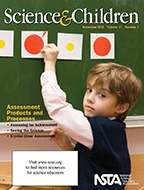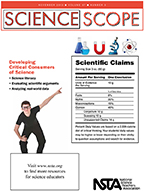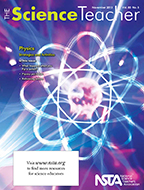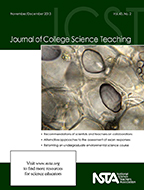NSTA's K-College Journals: Live for November
By Lauren Jonas, NSTA Assistant Executive Director
Posted on 2013-11-13
You’ve turned the clocks back an hour, but you’re still short on time—that’s what most teachers tell us! How can the National Science Teachers Association (NSTA) help? With grade-level journals targeted to your needs, written by educators who know what works. Our November journals are live online (with select articles being free for all, and full content being free to all NSTA members). Browse these issues for classroom-tested ideas, activities you can use tomorrow, and commentary from experts in the field.
 Science and Children
Science and Children
We all know that assessment should be ongoing, a seamless part of what we do each day in class. When done right, the outcome is rich, yielding an understanding of what students know and can do while allowing us to help them fill in the gaps and then build on their knowledge. This issue offers helpful strategies for developing effective, insightful assessments that support you as you develop instruction.
Featured articles (please note, only those marked “free” are available to nonmembers):
- … And Action!
- Free: Assessing for Achievement
- Crystal Clear Assessment
- Free: Editor’s Note: Seamless Assessment
- Scoring a Goal for Learning
- Seeing the Science
- Simply Performance Assessment
- Full Table of Contents
 Science Scope
Science Scope
Today’s students are bombarded by news not only in print but on screens everywhere around them. Now, more than ever, they need help in analyzing and critiquing the information that they are consuming. This issue is filled with strategies for developing critical consumers of science. We hope you’ll use these activities and lessons to remind students that just because something has been published, doesn’t mean it’s true!
Featured articles (please note, only those marked “free” are available to nonmembers):
- Free: Building Science Literacy by Reading Science News
- Free: Editor’s Roundtable: Developing Critical Consumers of Science and Engineering
- Engaging Middle School Students in the Analysis and Interpretation of Real-World Data
- Evaluating Scientific Arguments With Slow Thinking
- Human Impact on Water Quality: Conducting Inquiry Activities With Cyber Databases and ICTs
- Increasing Science Vocabulary Using PowerPoint Flash Cards
- Saturn, Science, and Cross-Curricular Literacy Standards
- Student-to-Student Collaboration and Coming to Consensus
- Full Table of Contents
 The Science Teacher
The Science Teacher
Last month’s issue looked at the impact of the newly released Next Generation Science Standards (NGSS) on chemistry instruction, focusing on the first physical science standard, “Matter and Its Interactions” (HS-PS1). This issue, focused on physics and physical science, will consider the NGSS‘s other high school physical science standards: Motion and Stability (HS-PS2), Energy (HS-PS3), and Waves and Their Applications in Technologies for Information Transfer (HS-PS4). Each standard relates performance expectations to disciplinary core ideas, crosscutting concepts, and scientific and engineering practices. This issue brings together several articles on physics that will help science teachers meet the challenges of today’s classroom.
Featured articles (please note, only those marked “free” are available to nonmembers):
- Free: Editor’s Corner: Physics Instruction in the Era of the NGSS
- Inexpensive Equipment for the Physics Classroom
- Physics Portfolios
- Rethinking Failure
- Toying Around
- Free: What Happens When You Flip a Switch?
- Full Table of Contents
 Journal of College Science Teaching
Journal of College Science Teaching
Read how the implementation of student-centered learning in introductory biology classes is being facilitated by the use of faculty learning communities at a large state university. Can web-based, collaborative annotation tools improve student participation and learning in academic settings? See the results of one study that focused on the Nota Bene tool. And in a study described in this issue, high school and undergraduate research students taking part in 10-week summer research programs were surveyed to determine their understanding of key concepts in science ethics and whether their understanding changed over the course of their programs.
Featured articles (please note, only those marked “free” are available to nonmembers):
- Free: Editorial: Rattled on the Reviewing Stand
- Free: Implementing Pedagogical Change in Introductory Biology Courses Through the Use of Faculty Learning Communities
- Light, Brain, and Action: An Introductory, Interdisciplinary Course on Optogenetics for Undergraduate Students
- Online Reading Informs Classroom Instruction and Promotes Collaborative Learning
- Reforming an Undergraduate Environmental Science Course for Nonscience Majors
- Research and Teaching: An Investigation of the Evolution of High School and Undergraduate Student Researchers’ Understanding of Key Science Ethics Concepts
- Research and Teaching: Blooming, SOLO Taxonomy, and Phenomenography as Assessment Strategies in Undergraduate Science Education
- Scientists’ and Teachers’ Perspectives About Collaboration
- Transformative Research-Based Pedagogy Workshops for Chemistry Graduate Students and Postdocs
- Full Table of Contents
Disclaimer: The views expressed in this blog post are those of the author(s) and do not necessarily reflect the official position of the National Science Teaching Association (NSTA).


